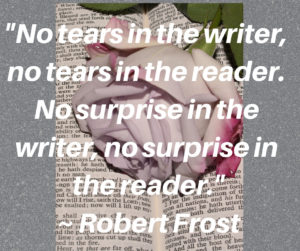By SUE COLETTA
 On TKZ, we’ve been known to beat the show-don’t-tell drum, because it makes the scene come alive. When a writer nails an emotion so perfectly, it’s easy to visualize the moment.
On TKZ, we’ve been known to beat the show-don’t-tell drum, because it makes the scene come alive. When a writer nails an emotion so perfectly, it’s easy to visualize the moment.
What’s your favorite emotion to portray?
What’s your crutch body cue that you edit out?
Care to share a favorite line or two from your WIP, published book, or from a story you’ve read that shows a vivid emotion?
Please also share the circumstances surrounding the character, so we can appreciate the emotion in the right setting.

Sadness & grief are interesting emotions to portray, especially when addressing a male reaction versus a female reaction. Not every man is stoic & not every woman is a crier & actions speak louder. It’s important to know your character & how they would react as individuals & be consistent as to motives, not cliched.
My crutch body cue is the “single tear.” There are only so many ways to describe a person crying from their POV but it’s a description I look for when editing. A crutch for me.
A fun post, Sue. Have a good weekend, girlfriend.
Ah, yes, the difference between genders. I often think, “How would my hubby react? How would our male neighbor differ? What about the dude at the butcher? He’s the polar opposite.”
My crutch is a shrug. I’m constantly searching for it while editing. There’s only so many ways to portray indifference, so it’s a tricky emotion.
Thanks, Jordan. You too! (((hugs)))
P.S. I set the post to go live at 6 a.m. EST, but obviously, I missed something when calculating West coast to East coast time zones. *facepalm*
I always set mine for 12:15 am on day of post. I do that for anyone international who follows our blog at different time zones.
Ah, good to know. Thank you! I’ll do the same. 🙂
This Aussie thanks you Jordan.
Now I have a face to think about when I post. My,pleasure, Jay.
My crutch is characters who are endlessly looking, staring, or glancing at each other. A wide range of emotions can be shown with a meaningful look–irony, humor, solicitude, pity, empathy, regret, shame, guilt, loss, triumph, joy, sorrow, love, hate, indifference, etc. The challenge is how to describe the meeting of the eyes in a fresh way.
My favorite emotion to portray is the melding of joy and sorrow. It’s also the most difficult. Something positive happens but the price is tragedy. For instance, a reconciliation between estranged family members that’s prompted by a diagnosis of a terminal illness.
Provocative questions, Sue. Thanks!
Eyes are a challenge, Debbie. There’s few words to actually say “eyes” & I fight not to fall into the trap of eyes that drop or fall (as in pop out of the head & fall) versus “a gaze” that shifts.
Gestures that portray emotion are ALL a problem for me. Too much shrugging, eyebrows winging, nodding, lips flattening, eyes narrowing. However, the eye thing is one that doesn’t bother me much – from a blog post I did years ago:
There seem to be two schools of thought on this one. I’m on the side that doesn’t mind. I understand that ‘eye’ can be used as a noun or a verb. “He eyed her” is acceptable. “He gave her the eye” is an idiom I have no trouble with. I don’t see him extracting an eyeball and handing it to her. So if a characters eyes move, I don’t get visions of eyeballs floating free.
Ha! I get visuals of eyeballs being tossed across the room, but I blame my editor for sticking that image in my mind.
I agree on these crutches for me. Nodding, lips flattening, eyes narrowing, shrugging.
The eyes are a dilemma. So are lifting arms, lol.
My favorite emotions to portray are love and hope. It doesn’t necessarily have to be a couple, even a family’s love for one another works.
Debbie …
Something positive happens but the price is tragedy. For instance, a reconciliation between estranged family members that’s prompted by a diagnosis of a terminal illness.
Sounds like a memorable scene!
My favorite emotion is pain. To read and write and see portrayed realistically on screen/stage.
I also have a problem with characters glancing. I just can’t keep track of where the character is looking, and I guess the screenwriting advice that a person can’t look at one thing for too long is stuck somewhere in my mind. But back to pain, it isn’t a crutch yet, but I think I’ll have to watch for the phrase “pain wracked his body” soon enough.
Haha. I can relate, AZAli!
Love the screenwriting advice. It makes perfect sense. And now it’ll be stuck in my mind, too. 🙂
Emotion: Anger or rage
Crutch: Sighing. So. Much. Sighing.
I’m finishing up a scene that ends with a young woman slicing a man’s hand with a paring knife when he tries to stop her from leaving the room.
Although…I struggle with emotions. Action is always my fallback. Am always trying to deepen my characters, but I worry I’ll slow the pace too much. Decisions, decisions.
Fun post! (Late to the party, per usual. Cheers!)
I feel your pain, Laura. My editor loves to harp on me for more emotion in dialogue. My first inclination is to write a rapid-fire conversation. She’s right, of course. Emotion adds another layer. Thank God for good editors.
Cheers!